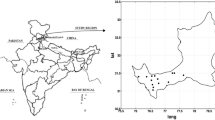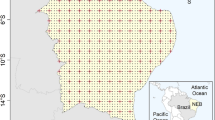Abstract
Daily rainfall occurrence and amount at 55 stations over New Caledonia (NC, 20°S, 166°E) are examined throughout the calendar year during 1980–2010 using a Hidden Markov Model (HMM). Daily rainfall variability is described in terms of six discrete rainfall states identified by the HMM. Three states are interpreted as trade wind regimes associated with persistent low level anticyclonic conditions and weak to strong easterlies. The most prevalent state (state 1; 36 % of days) is dry everywhere and is characterized by an elongated anticyclone centered around Australia; NC is located on the eastern edge of this anticyclone. This state is predominant from mid-May to mid-December and peaks in September. The second most prevalent state (state 2; 27 % of days) and the last trade regime (state 4; 12 % of days) are most frequent in austral summer. States 2 and 4 are associated with the subtropical anticyclone centered south of NC, close to its climatological location in austral summer, and light (state 2) to moderate (state 4) rainfall mostly along the windward coast. A distinct state (state 3; 11 % of days) is mostly associated with wintertime extratropical eastward traveling troughs between New Caledonia and New Zealand, inducing light rainfall over the SW of the main island of New Caledonia. The two last states 5 and 6 are infrequent (<15 % of days) but account for almost 70 % of total rainfall across the archipelago. They occur mostly in austral summer with their frequency of occurrence peaking in late February–early March. These states are associated with synoptic wave traveling eastward from eastern Australia leading to a strong influx of moisture from the equatorial latitudes when the associated cyclonic centre is located west of New Caledonia. The wettest state is also strongly modulated by intra-seasonal 15–80 days variability. These events contribute to intermittent southwestward shifts of the South Pacific Convergence Zone from its mean location northeast of New Caledonia. On interannual timescales, the occurrence of the rainfall states is modulated by El Niño Southern Oscillation (ENSO) events. The ENSO impact is strongest from mid-August to March with more (less) frequent trade regimes 1–2 and less (more) frequent unstable trade regime 4 and states 5–6 during central-Pacific warm (cold) ENSO events. Stochastic simulations of daily rainfall occurrence and amount at the 55 stations are generated by using predictors based on Niño 4 sea surface temperature index and a local intra-seasonal (15–80 days) OLR index superimposed on a climatological annual cycle. The cross-validated skill peaks in September–November.
















Similar content being viewed by others
References
Ambrizzi T, Hoskins BJ, Hsu H-H (1995) Rossby wave propagation and teleconnection patterns in the austral winter. J Atmos Sci 52:3661–3672
Barbero R, Moron V (2011) Seasonal to decadal modulation of the impact of El Nino/Southern Oscillation on New Caledonia (SW Pacific) rainfall. J Geophys Res 116:D23111
Barbero R, Moron V, Mangeas M et al (2011) Relationships between MODIS and ATSR fires and atmospheric variability in New Caledonia (SW Pacific). J Geophys Res 116:D21110
Basher RE, Zheng X (1995) Tropical cyclones in the south west Pacific: spatial patterns and relationships to Southern Oscillation and sea surface temperature. J Clim 8:1249–1260
Chang CP, Wang Z, McBride J, Liu CH (2005) Annual cycle of Southeast Asia—maritime continent rainfall and the asymmetric monsoon transition. J Clim 18:287–301
Delcroix T, Lenormand O (1997) ENSO signals in the vicinity of New Caledonia, South Western Pacific. Oceanol Acta 20:481–491
Fischer M, Dewitte B, Maitrepierre L (2004) A non-linear statistical downscaling model: El Nino/Southern Oscillation impact on precipitation over New Caledonia. Geophys Res Lett 31:L16204
Folland CK, Renwick JA, Salinger MJ, Mullan AB (2002) Relative influences of the interdecadal Pacific oscillation and ENSO on the South Pacific Convergence Zone. Geophys Res Lett 29:1643
Gill AE (1980) Some simple solutions for heat-induced tropical circulation. Q J Meteorol Soc 106:447–462
Haffke C, Magnusdottir G (2013) The South Pacific Convergence Zone in three decades of satellite images? J Geophys Res (Atmos) 118:10839–10849
Janicot S, Moron V, Fontaine B (1996) Sahel droughts and ENSO. Geophys Res Lett 23:515–518
Jourdain NC, Sen Gupta A, Taschetto AS, Ummenhofer CC, Moise AF, Ashok K (2013) The Indo-Australia monsoon and its relationship to ENSO and IOD in reanalysis data and the CMIP3/CMIP5 simulations. Clim Dyn 41:30733102. doi:10.1007/s00382-013-1676-1
Kanamitsu M, Ebisuzaki W, Woolen J et al (2002) NCEP-DOE AMIP-II reanalysis (R-2). Bull Am Meteorol Soc 83:1631–1643
Karoly J (1989) Southern hemisphere circulation features associated with El Nino-Southern Oscillation events. J Clim 2:1239–1252
Kidson JW, Renwick JA (2002) The southern hemisphere evolution of ENSO during 1981–99. J Clim 15:847–863
Lau NC, Nath MJ (2000) Impact of ENSO on the variability of the Asian–Australian monsoons as simulated in GCM experiments. J Clim 13:4287–4309
Lefévre J, Marchesiello P, Jourdain NC, Menkes C, Leroy A (2010) Weather regimes and orographic circulation around New Caledonia. Mar Pollut Bull 61:413–431
Leroy A (2006) Utilisation des prévisions saisonnières en Nouvelle-Caldonie. Note de la DP no. 6, Direction de la Météorologie, MétéoFrance, 169 pp
Leroy A, Céron JP (2007) Un défi de la prévision saisonnière: la descente d’échelle. La Nouvelle-Calédonie, un exemple à suivre. La Météorol 58:36–44
Leroy A, Wheeler MC (2008) Statistical prediction of weekly tropical cyclone activity in the southern hemisphere. Mon Weather Rev 136:3637–3654
Liebmann B, Smith CA (1996) Description of a complete (interpolated) outgoing longwave radiation dataset. Bull Am Meteorol Soc 77:1275–1277
Madden RA, Julian PR (1971) Description of a 40–50 day oscillation in the zonal wind in the tropical Pacific. J Atmos Sci 28:702–708
Madden RA, Julian PR (1994) Observations of the 40–50 day tropical oscillation—A review. Mon Weather Rev 122:814–837
Matthews AJ (2012) A multiscale framework for the origin and variability of the South Pacific Convergence Zone. Q J Meteorol Soc 138:1165–1178
Matthews AJ, Li HYY (2005) Modulation of station rainfall over the Western Pacific by the Madden–Julian oscillation. Geophys Res Lett 32:L14827
Meehl GA (1987) The annual cycle and interannual variability in the tropical Pacific and Indian Ocean regions. Mon Weather Rev 115:27–50
Morlière A, Rébert JP (1986) Rainfall shortage and El Nino-Southern Oscillation in New Caledonia, southwestern Pacific. Mon Weather Rev 114:1131–1137
Moron V, Vautard R, Ghil M (1998) Trends, interdecadal and interannual oscillations in global sea surface temperatures. Clim Dyn 14:545–569
Moron V, Barbero R, Mangeas M et al (2013) Prediction of September–December fire in New Caledonia (SouthWestern Pacific) using July Nino-4 sea surface temperature. J Appl Meteorol Clim 52:623–633
Nicet JB, Delcroix T (2000) ENSO-related precipitation changes in New Caledonia, southern Pacific: 1969–98. Mon Weather Rev 128:3001–3006
Revell CG, Goulter SW (1986) South Pacific tropical cyclones and the Southern Oscillation. Mon Weather Rev 114:1138–1145
Reynolds RW, Rayner NA, Smith TM et al (2002) An improved in situ and satellite SST analysis for climate. J Clim 15:1609–1625
Robertson AW, Kirshner S, Smyth P (2004) Downscaling of daily rainfall occurrence over Northeast Brazil using a Hidden Markov Model. J Clim 17:4407–4424
Robertson AW, Kirshner S, Smyth P et al (2006) Subseasonal-to-interdecadal variability of the Australian monsoon over North Queensland. Q J Meteorol Soc 132:519–542
Robertson AW, Moron V, Swarinoto Y (2009) Seasonal predictability of daily rainfall statistics over Indramayu district, Indonesia. Int J Climatol 29:1449–1462
Robertson AW, Moron V, Qian JH et al (2011) The maritime continent monsoon. In: Chang CP et al (eds) The global monsoon system: research and forecast, 2nd edn, World Scientific Publishing Co., New Jersey, pp 85–98
Sinclair MR (1993) Synoptic-scale diagnosis of the extratropical transition of a SouthWest Pacific tropical cyclone. Mon Weather Rev 121:941–960
Trenberth KE (1976) Spatial and temporal variations in the Southern Oscillation. Q J R Meteorol Soc 102:639–653
Trenberth KE (1991) Storm tracks in the Southern Hemisphere. J Atmos Sci 48:2159–2178
Van Der Wiel K, Mathews AJ, Stevens DP, Joshi MM (2015) A dynamical framework for the origin of the diagonal South Pacific and South Atlantic Convergence Zones. Q J R Meteorol Sci. doi:10.1002/qj.2508
Van Loon H (1984) The Southern Oscillation. Part III: associations with the trades and with the trough in the westerlies of the South Pacific ocean. Mon Weather Rev 112:947–952
Vera C (2003) Interannual and interdecadal variability of atmospheric synoptic-scale activity in the Southern Hemisphere. J Geophys Res 108:8077
Vincent DG (1994) The South Pacific Convergence Zone (SPCZ): a review. Mon Weather Rev 122:1949–1970
Vincent EM, Lengaigne M, Menkes CE, Jourdain NC, Marchesiello P, Madec G (2011) Interannual variability of the South Pacific Convergence Zone and implications for tropical cyclone genesis. Clim Dyn 36:1881–1896
Wheeler MC, Hendon HH (2004) An all-season real-time multivariate MJO index: development of an index for monitoring and precipitation. Mon Weather Rev 132:1917–1932
Wheeler MC, McBride J (2005) Australian–Indonesian monsoon. In: Lau WKM, Waliser DE (eds) Intraseasonal variability in the atmosphere–ocean climate system. World Scientific Press, New Jersey, pp 125–173
Widlansky MJ, Webster PJ, Hoyos CD (2011) On the location and orientation of the South Pacific Convergence zone. Clim Dyn 36:561–578
Wilks DS, Wilby RL (1999) The weather generation game: a review of stochastic weather models. Prog Phys Geogr 23:329–357
Acknowledgments
The early stages of this research (V.M., R.B.) were funded by a french ANR BIODIV grant (INCendies en Nouvelle Caldonie). A.W.R. was supported by MURI Grant N00014-12-1-0911 from the US Office of Naval Research.
Author information
Authors and Affiliations
Corresponding author
Electronic supplementary material
Below is the link to the electronic supplementary material.
Rights and permissions
About this article
Cite this article
Moron, V., Barbero, R. & Robertson, A.W. Subseasonal-to-interannual variability of rainfall over New Caledonia (SW Pacific). Clim Dyn 46, 2449–2468 (2016). https://doi.org/10.1007/s00382-015-2712-0
Received:
Accepted:
Published:
Issue Date:
DOI: https://doi.org/10.1007/s00382-015-2712-0




